Dohyun Kim
Reinforcement Learning-based Fault-Tolerant Control for Quadrotor with Online Transformer Adaptation
May 13, 2025Abstract:Multirotors play a significant role in diverse field robotics applications but remain highly susceptible to actuator failures, leading to rapid instability and compromised mission reliability. While various fault-tolerant control (FTC) strategies using reinforcement learning (RL) have been widely explored, most previous approaches require prior knowledge of the multirotor model or struggle to adapt to new configurations. To address these limitations, we propose a novel hybrid RL-based FTC framework integrated with a transformer-based online adaptation module. Our framework leverages a transformer architecture to infer latent representations in real time, enabling adaptation to previously unseen system models without retraining. We evaluate our method in a PyBullet simulation under loss-of-effectiveness actuator faults, achieving a 95% success rate and a positional root mean square error (RMSE) of 0.129 m, outperforming existing adaptation methods with 86% success and an RMSE of 0.153 m. Further evaluations on quadrotors with varying configurations confirm the robustness of our framework across untrained dynamics. These results demonstrate the potential of our framework to enhance the adaptability and reliability of multirotors, enabling efficient fault management in dynamic and uncertain environments. Website is available at http://00dhkim.me/paper/rl-ftc
Random Conditioning with Distillation for Data-Efficient Diffusion Model Compression
Apr 02, 2025Abstract:Diffusion models generate high-quality images through progressive denoising but are computationally intensive due to large model sizes and repeated sampling. Knowledge distillation, which transfers knowledge from a complex teacher to a simpler student model, has been widely studied in recognition tasks, particularly for transferring concepts unseen during student training. However, its application to diffusion models remains underexplored, especially in enabling student models to generate concepts not covered by the training images. In this work, we propose Random Conditioning, a novel approach that pairs noised images with randomly selected text conditions to enable efficient, image-free knowledge distillation. By leveraging this technique, we show that the student can generate concepts unseen in the training images. When applied to conditional diffusion model distillation, our method allows the student to explore the condition space without generating condition-specific images, resulting in notable improvements in both generation quality and efficiency. This promotes resource-efficient deployment of generative diffusion models, broadening their accessibility for both research and real-world applications. Code, models, and datasets are available at https://dohyun-as.github.io/Random-Conditioning .
COMPASS: A Compiler Framework for Resource-Constrained Crossbar-Array Based In-Memory Deep Learning Accelerators
Jan 12, 2025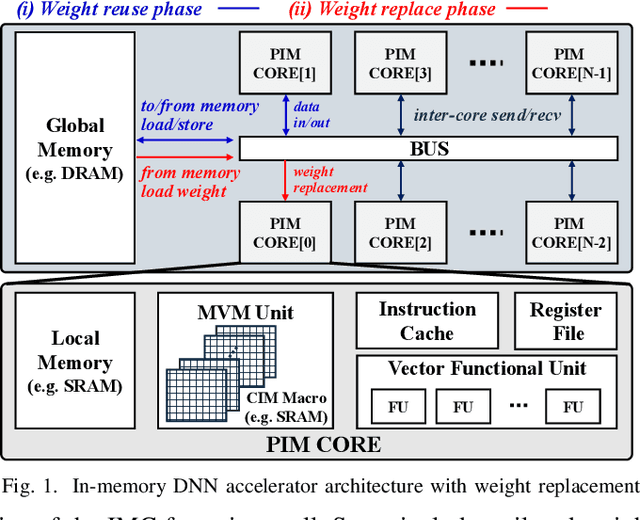
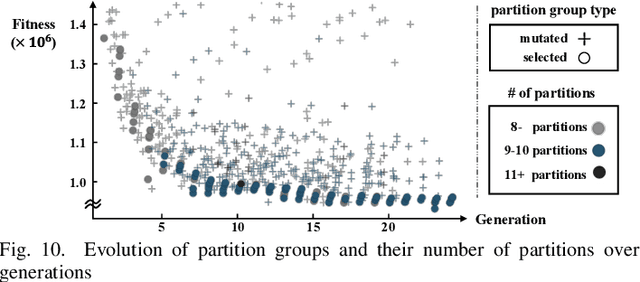
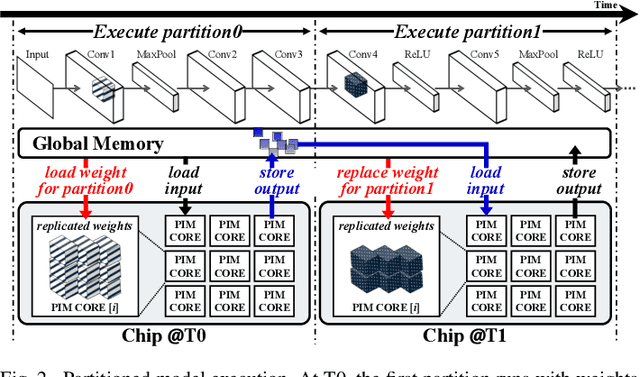
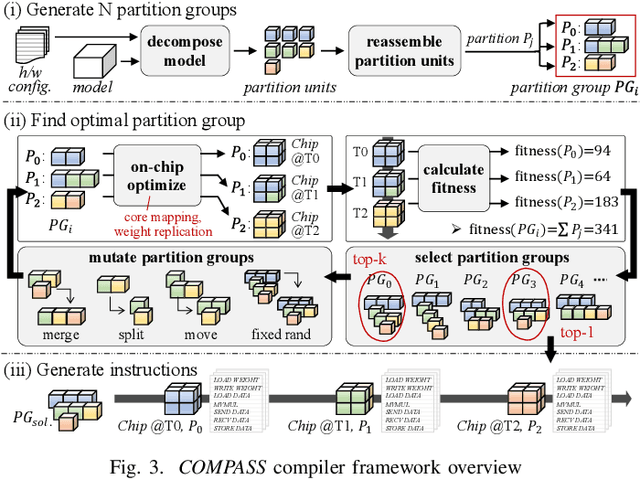
Abstract:Recently, crossbar array based in-memory accelerators have been gaining interest due to their high throughput and energy efficiency. While software and compiler support for the in-memory accelerators has also been introduced, they are currently limited to the case where all weights are assumed to be on-chip. This limitation becomes apparent with the significantly increasing network sizes compared to the in-memory footprint. Weight replacement schemes are essential to address this issue. We propose COMPASS, a compiler framework for resource-constrained crossbar-based processing-in-memory (PIM) deep neural network (DNN) accelerators. COMPASS is specially targeted for networks that exceed the capacity of PIM crossbar arrays, necessitating access to external memories. We propose an algorithm to determine the optimal partitioning that divides the layers so that each partition can be accelerated on chip. Our scheme takes into account the data dependence between layers, core utilization, and the number of write instructions to minimize latency, memory accesses, and improve energy efficiency. Simulation results demonstrate that COMPASS can accommodate much more networks using a minimal memory footprint, while improving throughput by 1.78X and providing 1.28X savings in energy-delay product (EDP) over baseline partitioning methods.
Learning from Convolution-based Unlearnable Datastes
Nov 04, 2024



Abstract:The construction of large datasets for deep learning has raised concerns regarding unauthorized use of online data, leading to increased interest in protecting data from third-parties who want to use it for training. The Convolution-based Unlearnable DAtaset (CUDA) method aims to make data unlearnable by applying class-wise blurs to every image in the dataset so that neural networks learn relations between blur kernels and labels, as opposed to informative features for classifying clean data. In this work, we evaluate whether CUDA data remains unlearnable after image sharpening and frequency filtering, finding that this combination of simple transforms improves the utility of CUDA data for training. In particular, we observe a substantial increase in test accuracy over adversarial training for models trained with CUDA unlearnable data from CIFAR-10, CIFAR-100, and ImageNet-100. In training models to high accuracy using unlearnable data, we underscore the need for ongoing refinement in data poisoning techniques to ensure data privacy. Our method opens new avenues for enhancing the robustness of unlearnable datasets by highlighting that simple methods such as sharpening and frequency filtering are capable of breaking convolution-based unlearnable datasets.
A Survey on Integration of Large Language Models with Intelligent Robots
Apr 14, 2024Abstract:In recent years, the integration of large language models (LLMs) has revolutionized the field of robotics, enabling robots to communicate, understand, and reason with human-like proficiency. This paper explores the multifaceted impact of LLMs on robotics, addressing key challenges and opportunities for leveraging these models across various domains. By categorizing and analyzing LLM applications within core robotics elements -- communication, perception, planning, and control -- we aim to provide actionable insights for researchers seeking to integrate LLMs into their robotic systems. Our investigation focuses on LLMs developed post-GPT-3.5, primarily in text-based modalities while also considering multimodal approaches for perception and control. We offer comprehensive guidelines and examples for prompt engineering, facilitating beginners' access to LLM-based robotics solutions. Through tutorial-level examples and structured prompt construction, we illustrate how LLM-guided enhancements can be seamlessly integrated into robotics applications. This survey serves as a roadmap for researchers navigating the evolving landscape of LLM-driven robotics, offering a comprehensive overview and practical guidance for harnessing the power of language models in robotics development.
LINGO-Space: Language-Conditioned Incremental Grounding for Space
Feb 02, 2024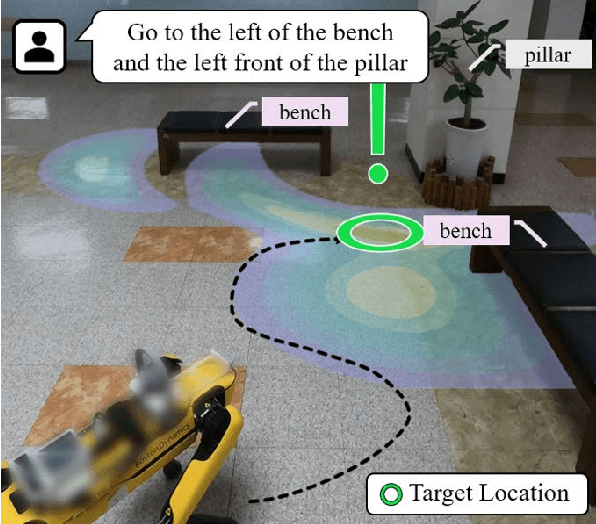



Abstract:We aim to solve the problem of spatially localizing composite instructions referring to space: space grounding. Compared to current instance grounding, space grounding is challenging due to the ill-posedness of identifying locations referred to by discrete expressions and the compositional ambiguity of referring expressions. Therefore, we propose a novel probabilistic space-grounding methodology (LINGO-Space) that accurately identifies a probabilistic distribution of space being referred to and incrementally updates it, given subsequent referring expressions leveraging configurable polar distributions. Our evaluations show that the estimation using polar distributions enables a robot to ground locations successfully through $20$ table-top manipulation benchmark tests. We also show that updating the distribution helps the grounding method accurately narrow the referring space. We finally demonstrate the robustness of the space grounding with simulated manipulation and real quadruped robot navigation tasks. Code and videos are available at https://lingo-space.github.io.
Joint Band Assignment and Beam Management using Hierarchical Reinforcement Learning for Multi-Band Communication
Aug 25, 2023



Abstract:Multi-band operation in wireless networks can improve data rates by leveraging the benefits of propagation in different frequency ranges. Distinctive beam management procedures in different bands complicate band assignment because they require considering not only the channel quality but also the associated beam management overhead. Reinforcement learning (RL) is a promising approach for multi-band operation as it enables the system to learn and adjust its behavior through environmental feedback. In this paper, we formulate a sequential decision problem to jointly perform band assignment and beam management. We propose a method based on hierarchical RL (HRL) to handle the complexity of the problem by separating the policies for band selection and beam management. We evaluate the proposed HRL-based algorithm on a realistic channel generated based on ray-tracing simulators. Our results show that the proposed approach outperforms traditional RL approaches in terms of reduced beam training overhead and increased data rates under a realistic vehicular channel.
SGGNet$^2$: Speech-Scene Graph Grounding Network for Speech-guided Navigation
Jul 14, 2023Abstract:The spoken language serves as an accessible and efficient interface, enabling non-experts and disabled users to interact with complex assistant robots. However, accurately grounding language utterances gives a significant challenge due to the acoustic variability in speakers' voices and environmental noise. In this work, we propose a novel speech-scene graph grounding network (SGGNet$^2$) that robustly grounds spoken utterances by leveraging the acoustic similarity between correctly recognized and misrecognized words obtained from automatic speech recognition (ASR) systems. To incorporate the acoustic similarity, we extend our previous grounding model, the scene-graph-based grounding network (SGGNet), with the ASR model from NVIDIA NeMo. We accomplish this by feeding the latent vector of speech pronunciations into the BERT-based grounding network within SGGNet. We evaluate the effectiveness of using latent vectors of speech commands in grounding through qualitative and quantitative studies. We also demonstrate the capability of SGGNet$^2$ in a speech-based navigation task using a real quadruped robot, RBQ-3, from Rainbow Robotics.
Joint Relay Selection and Beam Management Based on Deep Reinforcement Learning for Millimeter Wave Vehicular Communication
Dec 19, 2022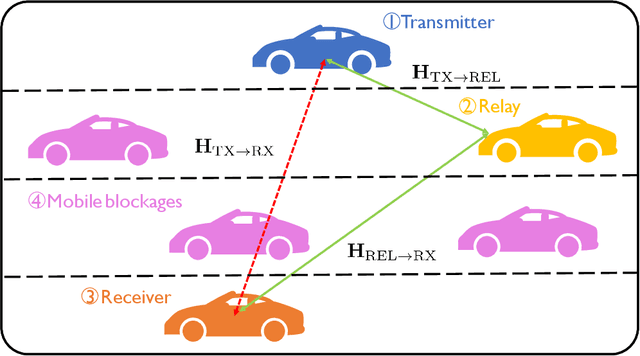
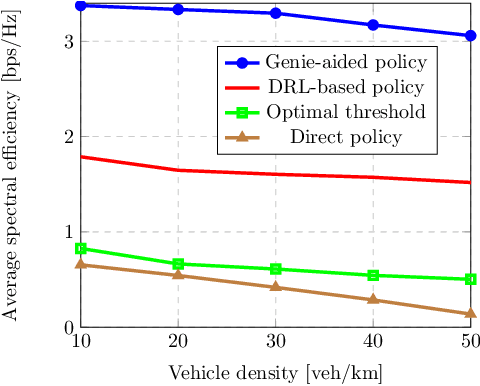
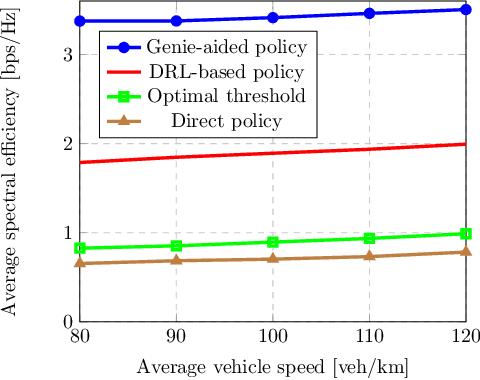
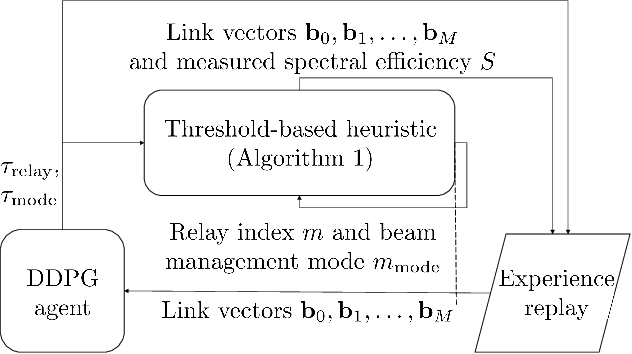
Abstract:Cooperative relays improve reliability and coverage in wireless networks by providing multiple paths for data transmission. Relaying will play an essential role in vehicular networks at higher frequency bands, where mobility and frequent signal blockages cause link outages. To ensure connectivity in a relay-aided vehicular network, the relay selection policy should be designed to efficiently find unblocked relays. Inspired by recent advances in beam management in mobile millimeter wave (mmWave) networks, this paper address the question: how can the best relay be selected with minimal overhead from beam management? In this regard, we formulate a sequential decision problem to jointly optimize relay selection and beam management. We propose a joint relay selection and beam management policy based on deep reinforcement learning (DRL) using the Markov property of beam indices and beam measurements. The proposed DRL-based algorithm learns time-varying thresholds that adapt to the dynamic channel conditions and traffic patterns. Numerical experiments demonstrate that the proposed algorithm outperforms baselines without prior channel knowledge. Moreover, the DRL-based algorithm can maintain high spectral efficiency under fast-varying channels.
Improving Multi-fidelity Optimization with a Recurring Learning Rate for Hyperparameter Tuning
Sep 26, 2022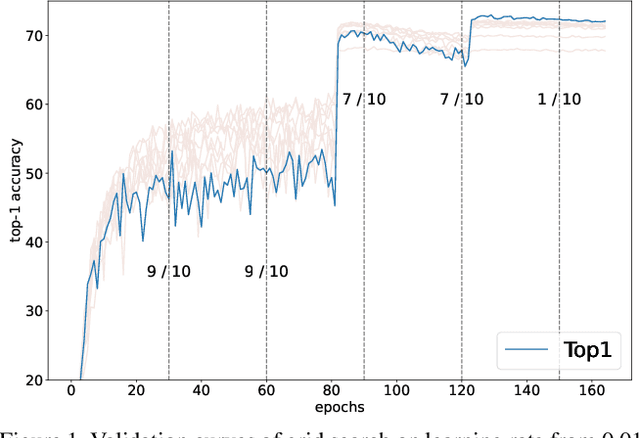
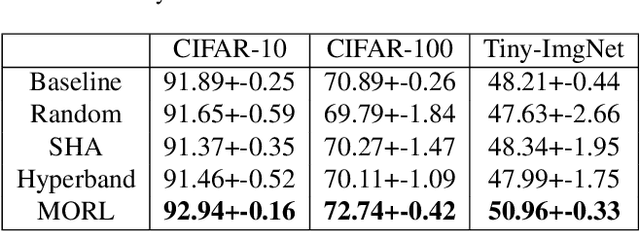
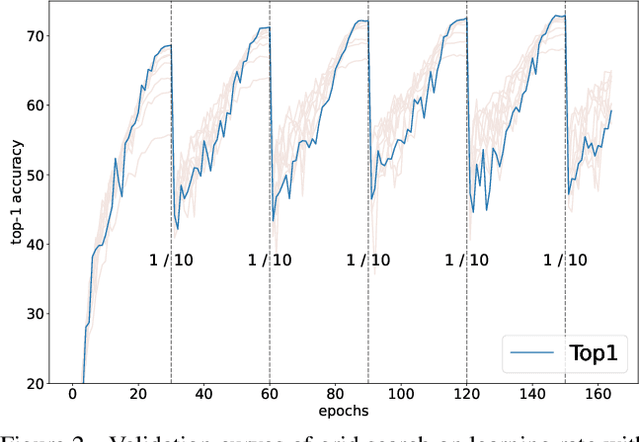

Abstract:Despite the evolution of Convolutional Neural Networks (CNNs), their performance is surprisingly dependent on the choice of hyperparameters. However, it remains challenging to efficiently explore large hyperparameter search space due to the long training times of modern CNNs. Multi-fidelity optimization enables the exploration of more hyperparameter configurations given budget by early termination of unpromising configurations. However, it often results in selecting a sub-optimal configuration as training with the high-performing configuration typically converges slowly in an early phase. In this paper, we propose Multi-fidelity Optimization with a Recurring Learning rate (MORL) which incorporates CNNs' optimization process into multi-fidelity optimization. MORL alleviates the problem of slow-starter and achieves a more precise low-fidelity approximation. Our comprehensive experiments on general image classification, transfer learning, and semi-supervised learning demonstrate the effectiveness of MORL over other multi-fidelity optimization methods such as Successive Halving Algorithm (SHA) and Hyperband. Furthermore, it achieves significant performance improvements over hand-tuned hyperparameter configuration within a practical budget.
 Add to Chrome
Add to Chrome Add to Firefox
Add to Firefox Add to Edge
Add to Edge